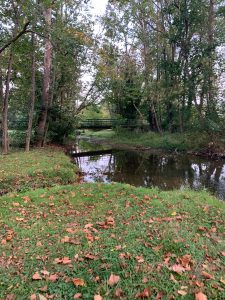
The location of my sit spot is off the main campus road (west campus drive) next to the creek. It is one of the areas along the creek where there is a cement culvert/retaining wall. I specifically chose an area along the creek next to one of these drains because I was wondering if the campus runoff created an observable effect on the stream. The particular culvert that my sit spot is next to is the one closest to the footbridge near the entrance to campus. The footbridge is southwest of where I sit.
My time spent doing quiet observation was as nice as always. I sat a little further away from the creek, so its noise was not quite as apparent but because I was not as focused on listening to it I listened more to what was going on in the canopy above me. This paid off as I heard numerous different bird calls. One of them was most certainly a crow and the other I could not identify but sounded like a high-pitched chattering. While I was not as focused on the creek this time I could actually hear it more easily. The water level was much higher than last time, I assume due to the recent precipitation. Also, the disturbance of the water over rocks that I sit next to was much more active.
With these base level observations out of the way I turned to my three things that I chose to follow last time. The first is the large sycamore tree that I sit under. I noticed as soon as I walked up to my site that it has dropped more leaves since the last time I visited. While it still had many of its leaves the forest floor had a thicker leaf cover and I was able to identify many of the leaves as sycamore. Besides that the sycamore stayed pretty constant. I was curious with the higher water levels if they maybe had affected the vegetation on the rock that I chose to follow as my second item. Surprisingly it seemed pretty unaffected. I have come to believe that the vegetation on it must be well established despite having little to no soil. The vegetation actually appeared greener and healthier this time as well, I assume due to the recent rain. The creek inlet, which was my third thing at my site to observe, did not change noticeably. Although further away from the stream in the drainage inlet from campus I, unfortunately, noticed some litter.
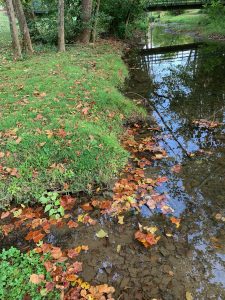
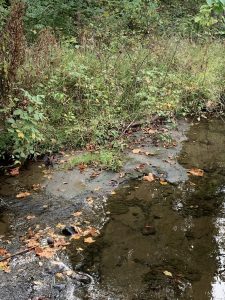
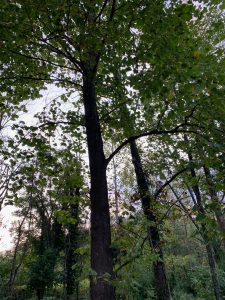
I was really quite excited to explore my sit spot in greater detail by moving around it even though I had already the week prior I took a more systematic approach in the hope that I would find even more interesting things. I first began by looking around the area immediately by where I sit but then moved up and down the creek along that area, I was determined to see something interesting in the creek. I saw a dragonfly when I was first looking and then just like the last time I was there, after looking long enough I was able to spot another crawfish. I was able to get a picture of it, although with its camouflage it is hard to see. Also near the end of my observation time, I found some trees with numbered metal tags on them. I wonder if this is part of a study or project done by someone on campus? While I was looking at the trees I also saw a monarch butterfly! It is pictured below!
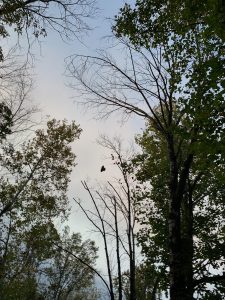
The first adaptation I made note of because it made it harder for me to see it, was the crawfished camouflage. Crawfish are extremely well camouflaged to look like the rest of the bottom of the creek and are really only visible if you see them move, which they don’t seem to do that often. The challenge this adaptation is addressing is predation. The camouflage lowers the chance the crawfish will be eaten. The next adaptation involved the monarch. I know that in Maine they are seasonal and travel south during the winter, just like the hawks we observed. I assume this particular butterfly is on its way south. The adaptation of migration addresses the challenge of the changing of seasons and the hardships (e.g. temperature and food variation or drop) that go with it. The final adaptation I took note of was the vines growing up the trees. They are particularly apparent to me because I spend a lot of time in the woods at home in Maine and we do not have nearly the abundance of vines I have noticed here. The challenge vines face is reaching sunlight in an area where being on the ground can make that hard. Therefore the adapted to grow up trees in order to reach a higher area where sunlight is more plentiful. These adaptations and challenges came to me relatively quickly although I did have to think about it for a minute and sort of switch from observation mode to a critical thinking mode.

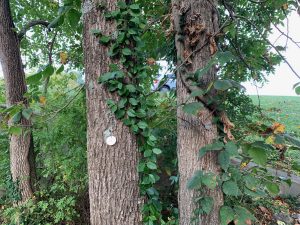
(Can you spot the crawfish? Hint it is in the very middle.)
I made an addition observation as I was going to leave my sit spot, I saw a massive number of one species of bird, I could not tell which, leaving the area in a flock. They were kind of far away but it was really cool to see. I almost did not noticed them they were so small, it almost looked like the sky was seasoned with pepper. To make a wild guess perhaps they were starlings? They appeared to be dark in color and I have seen large groups of starlings like that before. I got a picture of them although they are a bit hard to make out.
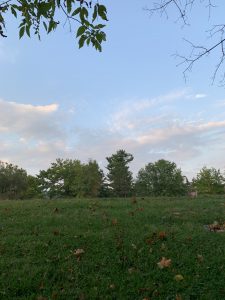

Hello!
One thing that surprised me about your blog post was that many of the observations were very similar to mine! That may be due to my sit-spot being directly across from you past the the bridge, and into the clearing directly towards the right.
Besides that, I really appreciate how you took the time to observe more closely into the stream, and take away more insight on some organisms such as the crawfish. I did not realize how well they camouflage themselves until now, and I’m curious to see if. I’d ever come across one myself.
good job 🙂
I really enjoyed reading your blog post and I think you did a great job making very detailed observations and then drawing different conclusions from those observations. I thought it was very interesting that you decided to sit near one of the campus drains, and I think it will be cool to see if the runoff has any noticeable effect.